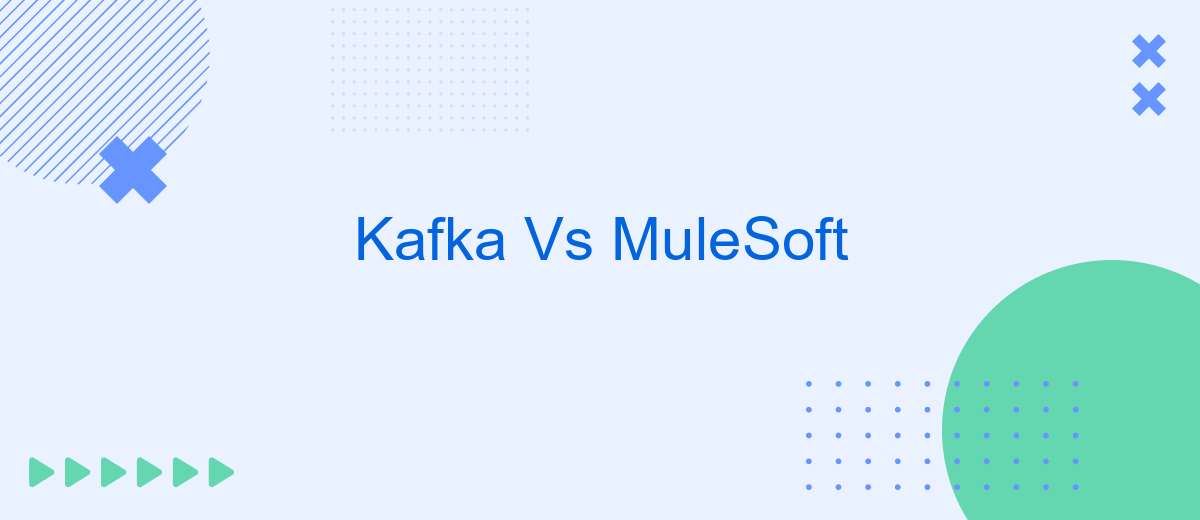In today's fast-paced digital landscape, businesses are increasingly relying on robust integration platforms to streamline their data flow and improve operational efficiency. Kafka and MuleSoft are two prominent solutions in this arena, each offering unique capabilities and advantages. This article delves into a comparative analysis of Kafka and MuleSoft, helping you determine which platform best suits your organization’s needs.
Messaging and Integration Capabilities
When comparing Kafka and MuleSoft in terms of messaging and integration capabilities, it's essential to consider their core functionalities. Kafka is a distributed event streaming platform primarily used for building real-time data pipelines and streaming applications. MuleSoft, on the other hand, is an integration platform that connects various applications, data sources, and APIs, enabling seamless data flow across different systems.
- Kafka: Offers high-throughput, low-latency messaging, suitable for real-time analytics and event-driven architectures.
- MuleSoft: Provides a comprehensive suite of tools for API management, data integration, and application connectivity.
- SaveMyLeads: Facilitates easy integration with various CRM systems, automating lead data transfer and enhancing workflow efficiency.
In summary, Kafka excels in handling large volumes of streaming data with minimal latency, making it ideal for real-time processing tasks. MuleSoft, with its robust integration capabilities, is better suited for enterprises looking to connect diverse systems and manage APIs efficiently. Services like SaveMyLeads can further simplify integration processes, especially for CRM-related workflows, by automating data transfers and ensuring seamless connectivity.
Architectural Differences

Kafka and MuleSoft exhibit distinct architectural paradigms that cater to different integration needs. Kafka, being a distributed streaming platform, focuses on high-throughput and fault-tolerant message processing. It is designed to handle real-time data streams, enabling efficient data ingestion and event-driven architectures. Kafka's architecture revolves around topics, producers, and consumers, ensuring scalability and durability through its distributed nature. This makes it ideal for scenarios requiring real-time analytics and seamless data flow across multiple systems.
On the other hand, MuleSoft operates as an integration platform as a service (iPaaS), emphasizing ease of integration and API management. MuleSoft's architecture leverages connectors, flows, and APIs to facilitate communication between disparate systems. It provides a comprehensive suite of tools for designing, deploying, and managing integrations, making it suitable for complex enterprise environments. Services like SaveMyLeads can further enhance MuleSoft's capabilities by offering pre-built integrations and automation, simplifying the process of connecting various applications and services. This approach ensures that businesses can achieve seamless connectivity and data synchronization with minimal effort.
Data Transformation and Enrichment

When it comes to data transformation and enrichment, both Kafka and MuleSoft offer robust capabilities, but they approach the task differently. Kafka, primarily a streaming platform, relies on its ecosystem of connectors and stream processing libraries like Kafka Streams or ksqlDB to perform real-time data transformations. MuleSoft, on the other hand, is an integration platform that provides a wide range of built-in connectors and DataWeave, a powerful data transformation language, to handle complex data manipulation tasks.
- Kafka: Utilizes Kafka Streams and ksqlDB for real-time data processing and transformation.
- MuleSoft: Offers DataWeave for intricate data transformations and a plethora of connectors for various data sources.
For businesses looking to streamline their data workflows, tools like SaveMyLeads can be invaluable. SaveMyLeads automates data integration between different platforms, making it easier to enrich and transform data without extensive manual intervention. Whether you choose Kafka for its real-time capabilities or MuleSoft for its comprehensive integration features, understanding the strengths of each can help you make an informed decision.
Reliability and Availability

When evaluating Kafka and MuleSoft in terms of reliability and availability, it's essential to consider their underlying architectures and design principles. Kafka, being a distributed streaming platform, is designed for high fault tolerance and durability. It replicates data across multiple brokers, ensuring that even if one broker fails, the data remains accessible.
MuleSoft, on the other hand, offers a robust integration platform that ensures high availability through its cloud-based infrastructure. MuleSoft's Anypoint Platform is designed to provide seamless failover and load balancing, ensuring that integrations remain operational even during service disruptions.
- Kafka: High fault tolerance through data replication across brokers.
- MuleSoft: Seamless failover and load balancing with cloud-based infrastructure.
- SaveMyLeads: Facilitates reliable integration setup with automated workflows.
Both Kafka and MuleSoft excel in providing reliable and available services, but their approaches differ. Kafka's strength lies in its distributed nature and data replication, while MuleSoft focuses on cloud-based reliability and seamless integration management. Additionally, services like SaveMyLeads can enhance MuleSoft's capabilities by automating and simplifying the integration process, further ensuring continuous availability.
Popularity and Community Support
When it comes to popularity, Kafka has a significant edge due to its widespread adoption in large-scale, real-time data processing environments. Companies like LinkedIn, Netflix, and Uber rely on Kafka for its robust performance and scalability. Kafka's strong community support is evident through its extensive documentation, numerous tutorials, and active forums where users can seek advice and share best practices. The Apache Kafka community is vibrant and continuously contributes to the platform's development, making it a reliable choice for many organizations.
On the other hand, MuleSoft has carved out its niche in the integration platform as a service (iPaaS) space, making it a popular choice for enterprises looking to streamline their integration processes. MuleSoft's Anypoint Platform is highly regarded for its ease of use and comprehensive integration capabilities. The community support for MuleSoft is robust, with a wealth of resources, including forums, webinars, and training programs. Additionally, services like SaveMyLeads can further enhance MuleSoft's integration capabilities by automating lead data transfers, making it easier for businesses to manage their customer relationships effectively.
- Automate the work with leads from the Facebook advertising account
- Empower with integrations and instant transfer of leads
- Don't spend money on developers or integrators
- Save time by automating routine tasks
FAQ
What is the primary difference between Kafka and MuleSoft?
Can Kafka and MuleSoft be used together?
Which platform is better for real-time data processing?
Is it difficult to integrate Kafka with other systems?
Can MuleSoft handle large volumes of data like Kafka?
If you use Facebook Lead Ads, then you should know what it means to regularly download CSV files and transfer data to various support services. How many times a day do you check for new leads in your ad account? How often do you transfer data to a CRM system, task manager, email service or Google Sheets? Try using the SaveMyLeads online connector. This is a no-code tool with which anyone can set up integrations for Facebook. Spend just a few minutes and you will receive real-time notifications in the messenger about new leads. Another 5-10 minutes of work in SML, and the data from the FB advertising account will be automatically transferred to the CRM system or Email service. The SaveMyLeads system will do the routine work for you, and you will surely like it.

